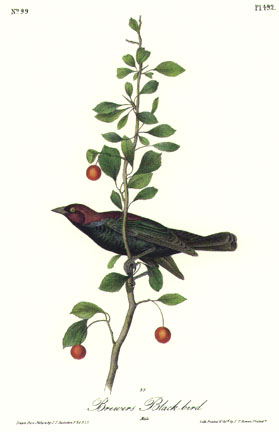

492 BREWER'S BLACKBIRD
| The country around Fort Union, which is situated a few miles above
the confluence of the Yellow Stone river and the Missouri, consists of a
large naked prairie, bounded to the eastward by a range of singular
hills, both in their form and diversity of altitude. This prairie, like
all others in that section of the country, is somewhat sterile, covered
with a superabundance of cactus of at least two kinds, and becomes burnt
and dried as early as the beginning of August. The hills themselves are
more or less abrupt, stony, and yet covered with many curious species of
plants. These hills extend for several miles, at about the same distance
from the banks of the Missouri; along their tops or their declivities,
many rare species of birds are found during spring and summer; but more
are met with on the surface of the great prairie below. At moderate
distances are seen more or less extensive ravines, where a few scanty
dwarfish trees, and tall rough weeds or grasses are found along the
margins of the small and mostly dried up rivulets that meander through
them. Reader, it is along the banks of these streamlets, and perhaps on
the branches of the trees which I have mentioned, that Brewer's
Blackbird may be found during almost all the morning rambles of the
student of Nature. Groups of seven or eight are seen to alight on the
branches in a loose manner, and in silence. They soon move upward or
downward, and allow you to approach within some fifteen or twenty paces
of them; and uttering their notes whilst you are watching their
movements, you are at once assured that it is a species as yet unknown
to the naturalists of our country, and therefore procure several of them
in a few moments.
They do not evince the pertness so usually accompanying our other birds of this family, but look all the while as if unsatisfied with their present abode and longing for a farther removal northward. On the ground their gait is easy and brisk, and I never heard them sing, but simply emit a cluck not unlike that of the Common Red-winged Starling, between which and Quiscalus ferrugineus I would place them. Their bill is not so stout as that of the former, but more so than that of the latter,. The shape of the wings and tail of this species differ materially from those of the Rusty Grackle; the first by its being longer, sharper, and having the first quill longest, and the tail being much more rounded. In the general colour those two species might agree better; but in the Q. Brewerii, the metallic resplendence is uniformly more brilliant, purple and blue, instead of being steel blue and green; it never shows the brownish edges of the feathers that are regularly attendant on those of the Rusty Grackle. I think it almost superfluous to add that I have named this species after my friend THOMAS M. BREWER, Esq.; having so often mentioned his name when he was actively engaged in the study of ornithology, and any works containing numerous evidences of the assistance he has rendered both to science and to myself. BREWER'S BLACKBIRD, Quiscalus Brewerii, Aud. 10, 16 1/4. Found on the Upper Missouri river, and Yellow Stone, &c. The old male measures from the point of the bill to end of tail 10 inches; alar extent 16 1/4; wing from flexure 5 1/4; bill along the ridge 3/4, along the gap 7/8. The first quill is decidedly the longest, the second and third shorter, and the rest rapidly decreasing. The bill and feet black, irides pale yellow. Tarsus 1 1/8; hind toe 1/2, its claw 3/8; middle toe 3/4, its claw 1/4. The general colour is deep glossy black, with rich purple reflections on the head, cheeks and lower sides of the neck; after which the reflections are first blue, and afterwards green. The lower parts are slightly glossed with green. Tail 4 inches. The female is somewhat smaller and duller in all its tints. Bill to end of tail 9 1/8 inches; wing from flexure 4 7/8.
|